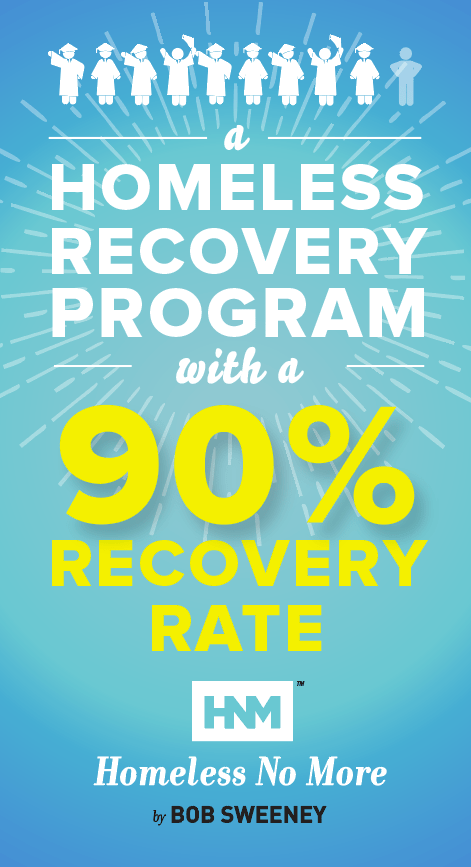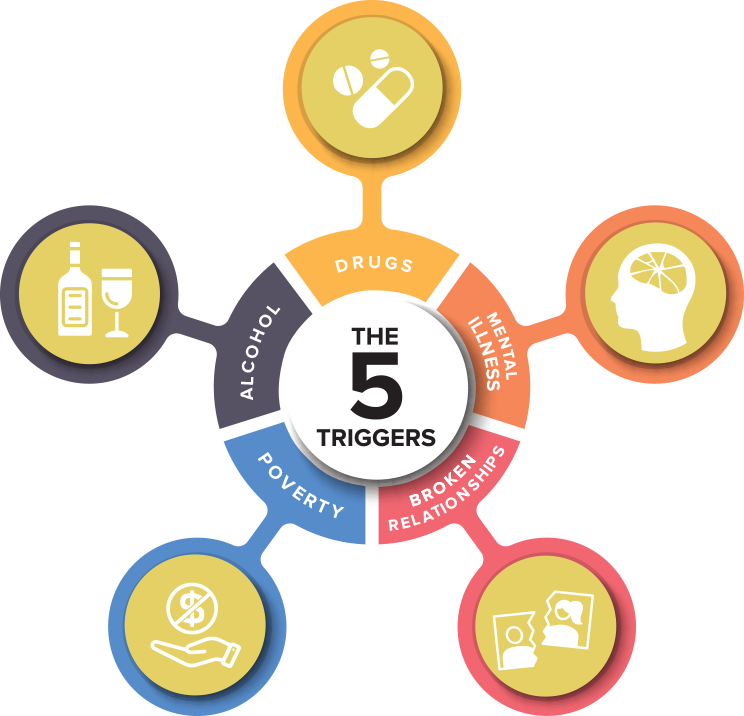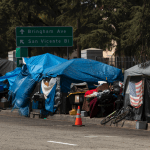In the vast expanse of the United States, the shadow of homelessness extends far and wide, touching lives across every state and city. As we delve into the “homelessness statistics in America” for 2023, we uncover a complex tapestry of stories and struggles. This past year, approximately 653,100 individuals faced nights without a roof over their heads, a number that speaks volumes about the challenges we face as a nation. 1 From the bustling streets of major cities to the quiet corners of rural areas, homelessness knows no bounds, affecting individuals and families, young and old. Behind each statistic is a human being with dreams, fears, and the hope (or lack of hope) for a better tomorrow. This post aims to shed light on the current state of homelessness in America, exploring the depth of the issue through numbers that reveal not just the scale of the problem, but also the urgent need for compassion, understanding, and action. As we navigate through the data, let us remember that behind every number is a story, a life, and a potential waiting to be realized.
How Many Homeless in America 2023
The landscape of homelessness in America has seen an unsettling rise in 2023. As mentioned previously, an estimated 653,100 individuals found themselves without stable shelter, marking a significant 12% increase from the previous year. 2 This escalation not only underscores the persistence of homelessness as a critical national issue but also brings to light the diverse challenges faced by affected individuals across the country. From weathering harsh conditions without a roof over their heads to the continuous search for safety and dignity, the homeless population in America confronts a daily reality that many of us can hardly imagine.
Make A Difference In The Lives Of Thousands
The situation is dire, but not without hope. Homeless No More stands at the forefront of change, working tirelessly to reduce the rising tide of homelessness with a remarkable 90% success rate. But we cannot do this alone. We need your help to reach out and make a tangible difference in the lives of thousands. Your contribution can provide not just shelter, but a pathway to a better, more stable life for those who have lost so much. Join us in our mission to extend a helping hand to every individual facing homelessness across the nation. See how you can help today and be a part of their journey to a brighter future.

U.S. Homeless Population by Year
The landscape of homelessness in America has evolved significantly over the years, reflecting broader economic, social, and policy changes across the nation. Tracing the “U.S. homeless population by year” unveils a narrative of fluctuating numbers, with periods of decline interspersed with spikes that challenge our progress in combating homelessness. From the data available, we’ve observed that the homeless population experienced a notable decrease from 2007 to 2016, a testament to concerted efforts and policies aimed at addressing the crisis. However, the trend reversed in recent years, with incremental increases leading up to 2020, exacerbated by the COVID-19 pandemic’s economic fallout. The pandemic underscored the vulnerability of many Americans, pushing the numbers upward despite significant federal interventions aimed at mitigating the impact. 3, 4 The distressing 12% increase from the previous year sets a new record since data collection began. This rise signals a critical juncture in our ongoing battle against homelessness, underscoring the need for renewed focus and sustained action to address the complex factors driving this increase. 5
Homelessness Statistics 2023
This next section delves into the specifics of the homeless crisis in the United States, providing a snapshot of the issue through a detailed demographic and regional lens. In 2023, homelessness has not only persisted but has also seen an alarming rise. This uptick is a stark reminder of the pervasive challenges that continue to plague our society. 6 Demographically, homelessness affects diverse groups, with significant disparities in racial and ethnic representation. Black Americans, who constitute 13% of the U.S. population, represent 37% of the homeless population, and nearly half of all families experiencing homelessness identify as Black. Hispanic or Latino individuals have seen a 28% increase, making up a significant portion of the homeless population as well. These statistics highlight the racial and ethnic inequities that significantly contribute to homelessness. 7 Regionally, the crisis is most acute in states with high housing costs and large urban populations, such as California and New York, which, combined with other populous states like Florida, Washington, and Texas, account for 55% of the nation’s homeless population. The per capita impact of homelessness also varies widely, with states like California experiencing the highest rates of homelessness per 10,000 residents. 8

Support Homeless No More
The data presented paints a troubling picture of homelessness in America, one that requires immediate and concerted efforts to address. By supporting Homeless No More, you have the opportunity to be part of a solution that has already shown remarkable success in helping individuals escape the cycle of homelessness. Our program’s approach is data-driven and tailored to meet the specific needs of those we serve, ensuring that our interventions are as effective as possible. Join us in making a difference today, and together, we can work towards a future where everyone that wants to recover from homelessness can. Your support can transform lives and communities. Learn more about how you can contribute to our cause and be a beacon of hope in these challenging times.
Causes of Homelessness in America
The roots of homelessness in America are deep and varied, intertwining socio-economic factors with systemic inequalities, and the main root causes of drugs, alcohol, mental illness, broken relationships, and poverty. Contrary to most leading sources, a fundamental lack of affordable housing is not the primary cause of homelessness, but a symptom — or a root cause or “trigger.” However, the housing crisis is a contributing factor to the rise in homelessness and must be addressed. High living costs, especially in urban areas, push individuals and families to the brink, often resulting in eviction or foreclosure. However, the causes extend beyond just housing costs and are a result of the five triggers: drugs, alcohol, mental illness, broken relationships, and poverty.

Read more about the five triggers of Homelessness here.
Unemployment or underemployment, with insufficient income to cover basic living expenses, is another significant contributing factor. Additionally, unexpected life events such as medical emergencies or family breakdowns can rapidly transform a stable situation into one of precariousness. Mental health issues and substance abuse, without adequate support and treatment, further exacerbate the risk of homelessness. Importantly, systemic issues such as racial discrimination and social inequality play a critical role, affecting access to housing, employment, and healthcare.
Causes of Homelessness Statistics
Data-driven insights offer a clearer understanding of the multifaceted causes behind homelessness. Studies have shown that a majority of individuals and families fall into homelessness due to economic hardships, primarily the inability to afford rent in the face of rising housing costs. In fact, a significant percentage of the homeless population cite job loss or financial struggles as their primary reason for their situation. We at Homeless No More add the five triggers to this list as the underlying triggers that lead to these symptoms of homelessness: economic hardships, job loss, or financial struggles.
Statistics also highlight the disproportionate impact on certain demographics. For example, ethnic minorities, particularly Black and Hispanic communities, are overrepresented in homelessness statistics, underscoring the systemic barriers they face. Veterans, despite various programs aimed at their support, continue to struggle with homelessness, often related to PTSD, substance abuse, and reintegration challenges.
Addressing homelessness effectively requires a nuanced understanding of its causes, guided by comprehensive data and an acknowledgment of the societal structures that contribute to it. By focusing on these root causes, we can begin to implement targeted solutions that not only provide immediate relief but also work towards long-term systemic change.
Homelessness Articles: Insights from the Front Lines
Recent articles from The Pew Charitable Trusts and The Bowery Mission offer profound insights into the homelessness crisis in New York, illustrating the broader national issue. Pew highlights the severe housing shortage and restrictive zoning practices as key drivers behind soaring rents and homelessness. New York’s struggle with housing construction lags significantly behind other major cities, contributing to low vacancy rates and high homelessness rates. In contrast, jurisdictions that have eased zoning laws and increased housing production have seen slower rent growth and lower homelessness rates, underscoring the need for policy reform to address these issues.9
The Bowery Mission paints a stark picture of homelessness in New York City, where nearly one in every 83 New Yorkers is homeless. This statistic reflects a city grappling with high living costs, a shortage of affordable housing, and a lack of living wage jobs. The majority of the city’s homeless population finds refuge in shelters, remaining largely unseen by the broader public. The Mission emphasizes the multifaceted precipitation of homelessness, including mental illness, substance abuse, medical issues, and the scarcity of affordable housing, highlighting the city’s all-time high homelessness rates and the urgent need for comprehensive solutions. 10
Homeless Rate by Country: A Global Perspective
Comparing the U.S. homelessness rate with other countries offers a global perspective on this pressing issue. While detailed international comparisons require nuanced data, it’s clear that homelessness is a worldwide challenge, exacerbated in regions with high living costs, inadequate social safety nets, and insufficient affordable housing.
Homeless Rate by State Per Capita: A Closer Look
Across the United States, homelessness rates vary significantly by state, influenced by factors like the five triggers of homelessness leading to the contributing factors such as: housing affordability, economic conditions, and state policies. States with high housing costs, such as California and New York, tend to have higher rates of homelessness per capita. In contrast, states with more affordable housing and comprehensive support systems may see lower rates. This variability underscores the importance of state-level policies and interventions in addressing homelessness, pointing to the need for targeted solutions that address the unique challenges of each state’s population that focus on the underlying causes of homelessness.
Addressing the Questions
What percentage of the US population is homeless?
The precise percentage of the U.S. population experiencing homelessness fluctuates. In 2023 against a population of over 331 million, the percentage is roughly 0.2%. This calculation offers a snapshot but may vary with new data and definitions of homelessness. 11
How many Americans are homeless in 2023?
In 2023, approximately 653,100 Americans were reported to be experiencing homelessness on any given night, marking a notable increase from previous years and reflecting the ongoing challenges in addressing homelessness across the nation. 12
What is the leading cause of homelessness in America?
I would challenge that contrary to popular opinion, there is no one, single leading cause of homelessness in America. Early in my career, I identified the underlying causes — or five triggers of homelessness to be drugs, alcohol, poverty, broken relationships, and mental illness. Although not root causes, challenges such as affordable housing, compounded by a variety of factors including poverty, unemployment, low wages, mental health issues, and substance abuse are important contributing factors to consider. The multifaceted nature of homelessness means that no single cause can be isolated; however, the critical shortage of affordable housing emerges as a contributing factor. 13
Which state has the highest rate of homelessness in America?
California has the highest rate of homelessness in America, with its large population and significant housing affordability crisis contributing to a substantial homeless population. The state’s high living costs and shortage of affordable housing options play a crucial role in its homelessness rate.
What are the 4 types of homelessness?
The three main types of homelessness include:
- Chronic Homelessness – Individuals or families with a disability who have been continuously homeless for a year or more, or have experienced at least four episodes of homelessness in the last three years.
- Transitional Homelessness – Individuals or families who experience a short-term loss of housing, often due to a sudden financial or personal crisis.
- Episodic Homelessness – Individuals who frequently enter and exit homelessness, often due to complex issues such as mental illness, substance use, or medical conditions.
- Hidden Homelessness – People who may not be on the streets but lack stable housing, staying with friends or in temporary accommodations without security or permanence.
What are the top 5 states for homelessness?
The top five states with the highest numbers of homelessness, according to recent data, are:
- California – With the largest absolute number of people experiencing homelessness, significantly impacted by housing affordability issues.
- New York – High rates of homelessness are exacerbated by the high cost of living and lack of affordable housing.
- Florida – Also faces significant challenges with homelessness, though the drivers may include a combination of housing affordability, income inequality, and access to social services.
- Texas – Homelessness in Texas is driven by affordable housing shortages, mental illness, addiction, and systemic institutional failures, affecting thousands statewide.
- Washington – In Washington state, over 25,000 people are homeless, with a need to build one million new homes by 2044, half for low-income residents.
These insights into homelessness in the United States underscore the complexity of the issue and the need for comprehensive, multi-faceted solutions that address the underlying causes of homelessness such as drugs, alcohol, mental illness, broken relationships, and poverty. 14, 15, 16 & 17
Conclusion
In conclusion, the state of homelessness in America is a complex issue driven by a myriad of factors including the root causes of homelessness (drugs, alcohol, mental illness, broken relationships, and poverty) in combination with secondary contributing factors, such as a lack of affordable housing, systemic inequalities, and personal crises. Addressing this issue is crucial for the well-being of thousands across the nation.
Support Homeless No More
Your support for the Homeless No More program can create real change. By contributing, you’re helping to extend effective solutions to those in need, based on comprehensive data and proven strategies. Join us in making a significant impact on homelessness in America. Your donation can help transform lives and communities. Learn more and contribute today.
References
- https://endhomelessness.org/homelessness-in-america/homelessness-statistics/state-of-homelessness/
- Ibid.
- https://www.security.org/resources/homeless-statistics/
- https://endhomelessness.org/homelessness-in-america/homelessness-statistics/state-of-homelessness/
- Ibid.
- https://endhomelessness.org/homelessness-in-america/homelessness-statistics/state-of-homelessness/
- Ibid.
- https://www.security.org/resources/homeless-statistics/
- https://www.pewtrusts.org/en/research-and-analysis/articles/2023/05/25/new-yorks-housing-shortage-pushes-up-rents-and-homelessness
- https://www.bowery.org/homelessness/facts-homelessness/
- https://endhomelessness.org/homelessness-in-america/homelessness-statistics/state-of-homelessness/
- Ibid.
- https://www.pewtrusts.org/en/research-and-analysis/articles/2023/05/25/new-yorks-housing-shortage-pushes-up-rents-and-homelessness
- https://www.security.org/resources/homeless-statistics/
- https://endhomelessness.org/homelessness-in-america/homelessness-statistics/state-of-homelessness/
- https://www.texastribune.org/2024/01/11/texas-homelessness-estimate/
- https://crosscut.com/politics/2023/01/how-was-legislature-addressing-housing-crisis-2023#
0007





